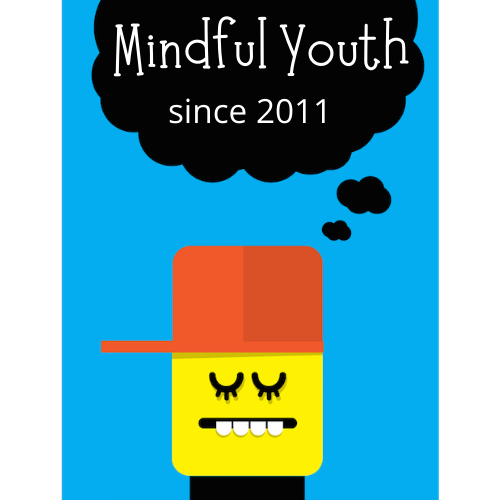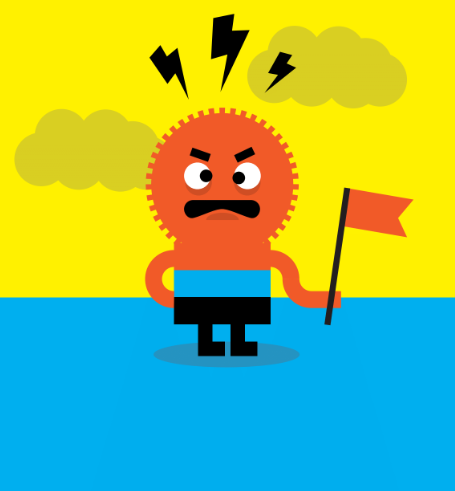When “calm” is a four-letter word
A meditation master will never instruct students to be calm; he simply invites students to be present. Calm is not discussed until advanced stages of meditation practice when students are reminded that any attachment to calm or pleasant mental states is simply that – an attachment.
Calm is a side-effect of mindfulness, not the goal. Misinformation about this has very real consequences for young students. Teens tend react with aversion to the word “calm,” rolling their eyes during a session of mindfulness instruction, because on some level they know it’s not a correct mindfulness teaching. Asian meditation masters do not use the word “calm.” They talk about cultivating detachment and letting go of preferences for pleasant or unpleasant experiences. They tell students to focus on their breath and to create space for whatever mental states arise without trying to control them.
In advanced stages of meditation practice, masters even warn students against attachment to calm, or pleasant mental states. This is because the long-term goal of meditation practice is to diminish attachment and aversion and in doing so, to develop an equanimous mind capable of facing and healing suffering. In short, we cannot heal what we cannot face. To insist on calm mental states in school is to instruct students to turn their attention away from that which needs healing. This creates a culture of denial as well as dangerous expectations in students that something is wrong with them if they don’t feel non-stop calm and happiness.
Let’s start with some examples of why it’s not correct to tell students to shift their mental states to calm when practicing mindfulness in education. Then I’ll explain why I prefer to use the word “quiet” instead of “calm.”
Example #1: Always practice mindfulness techniques on yourself first before teaching them to others. If you’re upset and someone says to you, “calm down,” do you feel more or less upset? Probably more upset. If you really want someone to cool down, it’s usually best to give the person space to feel what they need to feel until the upset burns out on its own.
Example #2: You don’t need to feel calm and peaceful to finish your work. Lots of people feel all kinds of unpleasant mental states throughout the day, power through them and achieve great success. Negative mental states are not something to fear or to eradicate. They are something we need to learn to face, work with and through. As the mind becomes accustomed to unpleasant difficulty, it adapts and difficulties begin to yield wisdom, perspective and creative solutions.
Example #3: Emotions and mental states are like weather. They arise and pass away of their own accord. We cannot control them; we can only observe them or choose to shift our attention to our breath or another object. This is our only power. Anyone who has done 7 hours of daily sitting meditation for 2 or 3-months at intensive meditation retreats knows that everyone hits a wall at some point. The calm dries up and reality remains. We cannot force calm. We cannot request calm. It arises and passes away of its own accord. If we could control our emotions and mental states, there would be far less suffering in the world. There would be no addiction, no jealousy. One of the profound truths of meditation practice is that we are not in control. Fortunately we can reconcile this with the realization that we do not need as much control as we think we do. At its full capacity, our mind is a crucible of tremendous power. It is able to face and transform its suffering.
More and more I’ve heard the word “calm” presented as the goal of mindfulness, in the media and among school counselors and teachers who have minimal or no meditation experience. Most likely the misuse of “calm” began with a failure to understand neuroscience. Americans have confused “physiological calming” of the nervous system (which recent neuroscience tells us occurs when students observe their mindful breathing) with a “calm mental state.” Calming the nervous system is different from shifting one’s mental state from upset to calm. The term “physiological” refers to physical body function, not the mind function. Although they are related, this is an important distinction. I’ve heard counselors and teachers telling defiant students to change their mental states to calm, when what they mean to say is not “calm down” but “quiet down.” Quiet is a much more practical goal. You are accepting the upset in children but asking them to respect their environment. We cannot choose our mental states but we can choose our behavior. A person can feel turbulent on the inside and still remain quiet, or at least turn down the volume, on the outside.
Quiet can lead to calm, but only if the word “calm” remains a silent, unspoken possibility - not a goal. A mindfulness instructor should always model the mental states he wants students to experience, but never demand that others feel them, which is just an act of aversion rather than acceptance of what is. When we tell students to feel calm rather than be quiet, we are asking them to deny their own realities rather than acknowledge and heal them. As mindfulness instructors we can diminish our aversion to unpleasant experiences and attachment to calm through long-term meditation practice, humble observation and by being honest about what is happening – not by denying reality. When we as instructors demonstrate the ability to face enormously unpleasant experiences, we provide a model for students to follow.
This is especially important when teaching students in special education. I witnessed an upset student with high-functioning autism repeatedly being told to shift his mental state to calm all day long by all the adults around him, who implored him to “breathe!” A highly sensitive student with a very mathematical and literal mind, he tried very hard. His tortured efforts to achieve calm sounded like this:
“I’m trying, I’m trying, I’m trying…. I’m bad, I’m bad, I’m evil, I’m evil.”
No matter how much he tried, he could not change his mental state from upset to calm and, while I can’t definitively say why he was saying “I’m bad, I’m evil,” I interpreted this reaction as similar to the reaction that many beginners have when they first try practicing mindfulness or meditation: they take a moment to be quiet, notice unpleasant sensations and immediately come to the conclusion that they are not good at mindfulness and quit. The expectation of a calm experience sabotages our ability to recognize correct practice - that in fact noticing what is actually happening is far more important than feeling a pleasant mental state. This student with autism may have decided he was defective because he couldn’t magically transform his mental state to “calm” as instructed. In this context, it is not the student who is bad, but the word “calm.” It is a four-letter word that should not be used to instruct. Mindfulness instructors should model calm, not demand it of others. When I began working with this student, he reported to me that his upset felt like heat in his body – a very perceptive observation. I told him not to try to make the heat go away, but to simply observe it until it cooled. I told him there was nothing wrong or evil about being upset. It just means he is human – just like me, just like everyone else. Unpleasant mental states are not a big deal. They arise and pass away just like pleasant ones, just like the weather. We acknowledge them and then shift our attention elsewhere when it’s appropriate.
While we are powerless to control the clouds of negative mental states that pass over our hearts, we can open our hearts to what is – pleasant or unpleasant – and learn to work with all forms of experience. When we accept our human imperfections, not attached to “good” mental states or fearful of “bad” mental states, detachment arises on its own and with it, calm. The moment we hold on too tightly to calm, a Buddhist concept known as “grasping,” the calm we seek slips away from us. It arises only when we do not seek it but instead work to stay present (with gentleness and love) with what is. That means facing all the aspects of our selves and our lives including those aspects that make us feel profound aversion and pain. It also means not forcing others to face their aversion and pain until they are ready.
This mindful process of opening the mind and heart to the full experience of our selves and our lives is a practice of discovery. When we choose it, there is no limit to the self-change and mental and physical well-being we can create for ourselves. When others prematurely force the concept of calm on us to control our behavior - when it is not our choice and we misunderstand it - the end result can be damaging and stop all progress on the mindfulness path. Don’t use “calm” to control others. Keep the calm to yourself. If you are truly calm yourself, it will be evident to others and serve as a quiet source of inspiration.
I’ve found that students with high functioning autism are usually right about most subjects and I always carefully contemplate what they say before correcting them in any way. When working with anxious students with autism, for example, often they will report accurately that their emotions are beyond their control. This is actually one of the first meditation insights into reality. Another insight is that what we don’t know far exceeds what we know. If we acknowledge the vast unknown, we allow each person’s mindfulness practice to unfold on its own without interfering or trying to control. We ask students to tell us what they notice and then use the Socratic method of questioning to guide them toward other aspects they might notice as well but we remain humble, scientific and in hypothesis-mode rather than claiming "right" answers. We never tell students that what they have noticed is wrong because aspects of truth are possessed by all people even those who are emotionally disturbed and what seems like delusion in one moment can bloom into truth in the next. If you have sat for months in silence and faced yourself and your own demons, you are humbled and freed by that awareness. If you have not yet spent months on silent retreat, I highly recommend it. We can always practice mindfulness with others but we cannot guide others until we truly know ourselves and are willing to face our own suffering as well as the suffering in others.
The student with high-functioning autism who had been so traumatized by “calm-based” mindfulness instruction – equating his breath with his failure to control his emotions – was hyperventilating any time he watched his breath. As a result I could not use mindful breathing as a technique with him. Instead I took him outside and asked him to notice sounds. He spent a long time standing below the trees, with his head tilted skyward. As he listened to the wind, the birds, to the sounds of airplanes and cars, he calmed down naturally. I never forced him to use this technique but anytime he was extremely upset, I asked him how he would like to manage his upset. He began to do his mindful listening practice automatically during or right before periods of upset – stepping outside for a few minutes to shift his attention to the physical world and then returning to his work when he felt better. Ironically because I invited him to be present and not calm, his calm demeanor arose all by itself.
© 2016 Copyright by Ellen McCarty. All rights reserved.

